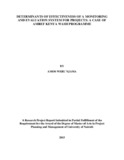Determinants of effectiveness of a monitoring and evaluation system for projects: a case of Amref Kenya wash programme
Abstract
Project monitoring and evaluation is an integral part of the project cycle and of good
management practice. An effective monitoring and evaluation system is fundamental if the goals
of a project are to be achieved. Through setting up proper monitoring and evaluation systems,
planning, efficiency and proper funds utilization can be achieved thus enhancing the
performance of projects. This study sought to analyze the determinants influencing effectiveness
of a monitoring and evaluation system for AMREF Kenya WASH programme. The research was
guided by the following objectives; to establish the extent to which availability of funds
influences the effectiveness of M&E system, to assess the extent to which stakeholders
participation influence the effectiveness of M&E system and to determine the extent to which
organization leadership influences the effectiveness of M&E system. The study was guided by
the program theory, theory of change and the dynamic capabilities theory. The study adopted a
descriptive survey research design in solving the research problem. The study targeted 66
employees of AMREF Kenya working under the WASH programme and in human resources,
finance and administration departments. Due to their small number, a census was conducted. The
response rate was 88%. The study utilized a questionnaire in collecting primary data. An
interview guide was also used to interview key informant persons in the organization who
included departmental heads, senior managers, M&E experts and consultants. A pilot test was
undertaken where questionnaires were administered to 10 respondents from other programmes to
assess the reliability and validity of the data instruments. The instrument’s content and construct
validity were determined through the help of expert judgment who assessed the instrument and
found out it answered the phenomenon under study. A Cronbach alpha test was conducted to
measure the internal consistency and reliability of the data collection instruments and was found
out to be 0.85 meaning the instruments were reliable. Collected data was edited, sorted, cleaned
and coded for data analysis using SPSS statistical package. The findings were analyzed using
means, standard deviation, percentages and frequencies then presented using tables. Availability
of funds, stakeholders participation and organization leadership were found to have a positive
correlation with effectiveness of M&E system with correlation coefficients of 0.489, 0.565 and
0.736 respectively. The level of association between the independent and dependent variables
was assessed by estimating a linear regression analysis and the coefficient of determination (R2)
was 0.755. The findings further indicated that Amref allocates funds to M&E activities and has a
separate allocation for M&E but the funds are not sufficient and the M&E unit is not
independent. On stakeholders participation, involvement is mainly on lower level activities but
not adequate in higher level activities. Finally, it was established out that organization’s
leadership greatly influences effectiveness of M&E system. However, majority of the
respondents felt that the leaders were not doing enough to support and enhance effectiveness of
the M&E system within the organization.
Publisher
University of Nairobi
Collections
- Faculty of Education (FEd) [6022]

